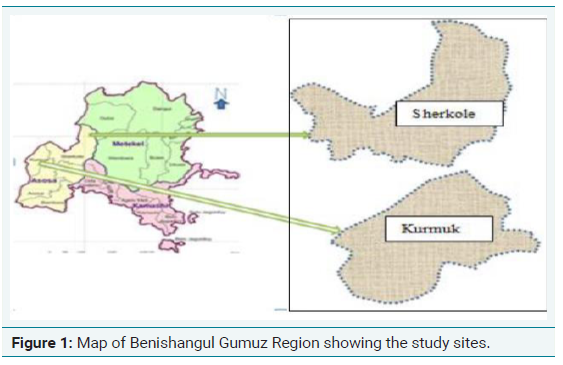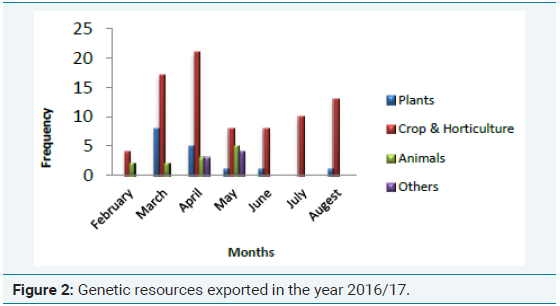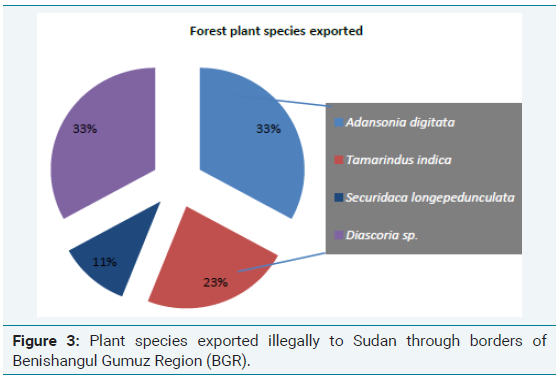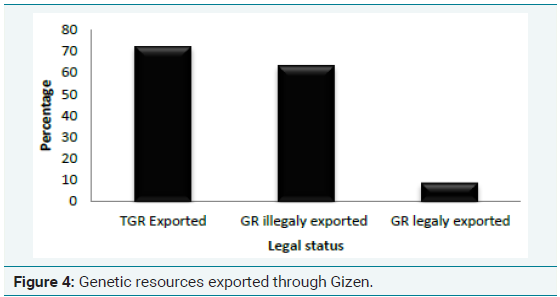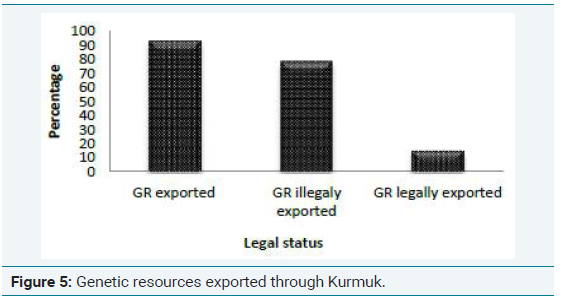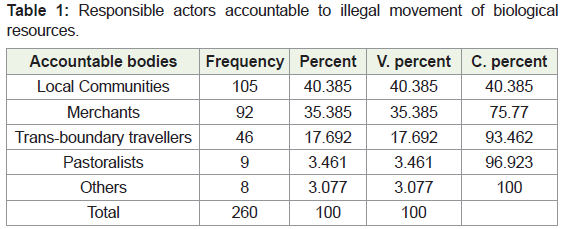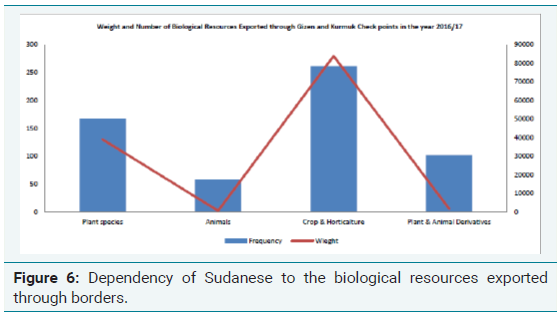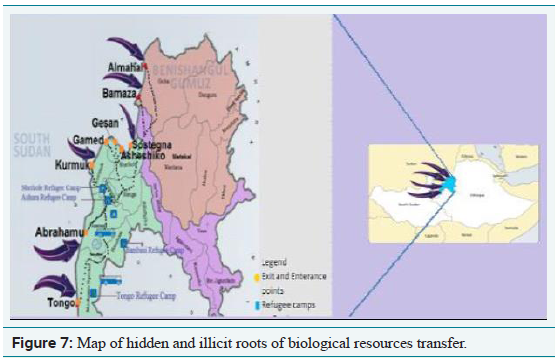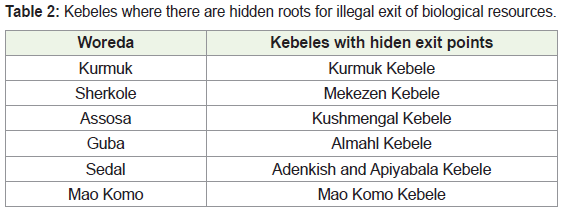Research article
Survey of Illegal Plant Genetic Resources Transfer through Borders of Benishangul Gumuz Regional State, Ethiopia: The Case of Sherkole and Kurmuk Check Points
Dereje Mosissa1*, Aesho Kefiyalew2 and Degitu Dereso3
1Forest and Rangeland Case team, Asssosa Biodiversity Center, Ethiopian Biodiversity Institute, Ethiopia
2Ethiopian Biodiversity Institute, Genetic Resources Access and Benefit Sharing Directorate, Sherkole-Gizen Custom Check Point Biologist, Ethiopia
3Ethiopian Biodiversity Institute, Genetic Resources Access and Benefit Sharing Directorate, Kurmik Custom Check Point Biologist, Ethiopia
Corresponding author: Dereje Mosissa, Forest and Rangeland Case team, Asssosa Biodiversity Center, Ethiopian Biodiversity Institute, Assosa, Ethiopia, Africa, E-mail: derament5964@gmail.com
Citation: Mosissa D, Kefiyalew A, Dereso D. Survey of Illegal Plant Genetic Resources Transfer through Borders of Benishangul Gumuz Regional State, Ethiopia: The Case of Sherkole and Kurmuk Check Points. J Plant Sci Res. 2017;4(2): 173.
Copyright © Mosissa D et al. 2017. This is an open access article distributed under the Creative Commons Attribution License, which permits unrestricted use, distribution, and reproduction in any medium, provided the original work is properly cited.
Journal of Plant Science & Research | ISSN: 2349-2805 | Volume: 4, Issue: 2
Submission: 02/11/2017; Accepted: 20/12/2017; Published: 29/12/2017
Abstract
One of the National Biodiversity Strategy and Action Plan (NBSAP) target to realize the mission of reducing pressures on biodiversity is “reduction of unsustainable utilization of biodiversity and ecosystem services”. Thus ultimately tackles and controls illegal movement of biological resources of the region. Therefore, the objective of this study is to survey the current status, routes, impact, means, involved actors and management of illegal access to genetic resources particularly in Benishangul Gumuz Regional State, Asosa and Metekel Zone. Data were collected from a total of 92 informants selected purposively from Kumruk District and Sherkole (Gizen) district of Asosa Zone governmental officials, community elders, and custom offices. Semi structured interviews, structured questioners; focus group discussion and document analysis were used for data collection. 95.6% of the informants reported that genetic resources are illicitly transferred from Ethiopia through Sudan and South Sudan to Kenya and Egypt. The local communities were the responsible actors involved (40.385%) in the illegal access to biological resources followed by transboundary travelers (35.385%). 26.9% of the respondents reported that plants, animals and their derivatives have been illegally transferred to neighboring countries and (16.8%) of them said that animals have been illegally transferred to neighboring countries. 43.7% of the informants stated that the overall multiple impact and trend of illegal access to genetic resources in the future would become high and increased sharply respectively and 42.9% of them said that the current status and trend of illegal access to genetic resources would be intermediate and constant trend respectively. The result revealed that considerable amount of biological resources around Benishangul Gumuz Regional State (BGRS) has been subjected to piracy through both check points and hidden roots, which will have a probability of intermediate continual impact in the countries biodiversity in the future if appropriate measures are not taken. Therefore, border checkpoints should be strengthens in humancapacity and facilities to monitor whether Prior Informed Consent (PIC), Mutual Agreed Term (MAT), Multilateral System and other legal requirements of a particular permit are fulfilled and to undertake technical control. Besides, authoritative and concerned governmental Institution of the two countries (South Sudan, Ethiopia and Sudan) should work cooperatively to curve out the ecological and economic effects of illegal access to genetic resources by developing and implementing further proper controlling intervention techniques.
Keywords:
BGR; Biological resources; Illegal access; Involved actors; NBSAP; Mutual agreed term
Introduction
Before the coming in to force of Convention on Biological Diversity in 1993, biological resources are regarded as common heritage of mankind and anyone can collect and use these natural resources. For instance researchers, scientists and tourists, could simply arrive at a field site, collect samples and take them wherever they goes because living species were regarded as the common heritage of mankind.
On this line of thinking, private companies and individuals could take and use the resources without any regulatory framework and benefit sharing to the party providing the genetic resource. But, after the coming in to force of the Convention on Biological Diversity (CBD), principle of national sovereignty of Parties on genetic resources have been set in order to strengthen legitimate ownership and protection of genetic resources from misappropriation and bio-piracy. Specifically Article 15 of the Convention on Biological Diversity recognizes that the sovereign rights of states over their natural resources, as well as their authority to determine access to genetic resources subject to their national legislations [1].
States have the sovereign rights to regulate access to genetic resources on their territories. Users of genetic resources are obliged to share benefits from utilized resources with source countries. In order to facilitate access and benefit sharing, appropriate legislative, administrative and policy measures have to been taken by both resource and user countries. In line with the international legal framework with regard to access to genetic resources, the national legislation of Ethiopia called access to genetic resources and community knowledge and community right proclamation with its implementing regulation puts a requirement of access permit before accessing genetic resource [2].
Ethiopian Biodiversity Institute has a mandate to grant access permit [2-4]. The main threats to biological diversity of Ethiopia are the ever increasing demand for export (both legal and illegal) market for cattle, goat, sheep and camel. The National Biodiversity Strategy and Action Plan of Ethiopia have a mission of reducing pressures on biodiversity and ecosystems [5,6]. Therefore, one of the national targets to realize the above mentioned mission of the NBSAP is reducing unsustainable utilization of biodiversity and ecosystem services [5]. Target 5 of the NBSAP ultimately focused on tackling and controlling illegal movement of genetic resources through creating awareness to the society on genetic resources access and benefit sharing legal procedures to enable utilization of the countries biodiversity in a sustainable manner.
Ethiopia shares a border with Somalia, Kenya, Sudan, South Sudan, Eritrea and Djibouti on various directions.
Materials and Methods
Description of the study area
The study was conducted in Benishangul Gumuz Region Asosa Zone particularly in Sherkole and Kurmuk districts. Sherkole is located in Benishangul-Gumuz regional state in western Ethiopia at 340 28‟ 48.29‟‟ to 350 13‟ 3.14‟‟E and 100 26‟18.98‟‟ to 110 14‟25.65‟‟ N with an altitude range between 500 and 1000 m a.s.l (Figure 1). The total annual rainfall varies from 900-1200 mm with mean annual temperature ranging in 10.8-420 °C [7]. The geology of the study area is characterized mainly by the occurrence of intrusive rock [8]. Dominantly occurred soils in the study area include among others dystric nitosols and calcaric and eutric fluvisols [9]. The climate of the study area is characterized by semi-arid climatic condition [10]. The total land area of the district is 351,857 ha, out of which 6.89% cultivated land, 55.25% wooded and shrub land, 18.66% grass land and 19.20% other land uses.
The District is covered with relatively tall trees; at least with 20% canopy coverage including integral open space and felled areas that are awaiting restocking, the predominant species found in the area are Combretum sp., Terminalia sp., Cordia africana, Adansonia digitata, Tamarindus indica, Dalbergia melanoxylon, Ficus sp. and Boswellia papyrifera [11,12]. The area is also covered by small trees, bushes, and shrubs, that are special and restricted to the region and in some cases mixed with grasses; Small grasses are the predominant natural vegetations of the area which are important for grazing and browsing of animals. The area is also allotted to extended rain fed crop production, mostly oil seed, cereals and pulses. Animal production of the species such as cattle, sheep, goats, asses, poultry of all species and beehives is a common practice in the area.
The total population of the district is about 19,992 with 4,237 households. Sherkole has a population density of 6 /km2, which is far below compared to the national average [8].
Kurmuk District is situated in the far western side of the region. The Centre of the woreda at Kutaworke/Horazab is 89 km from Asosa. Like Sherkole the woreda is mainly lowland, and it covers a similar area of just over 1400km2, divided into 16 kebeles. However its population is at around 21,000 people [8], of which most are Berta. Kurmuk is linked with Asosa by a main road. This road is an important route between Ethiopia and Sudan. The main annual crops grown in the district include maize, sorghum, haricot bean, sesame, noug (Niger seed), millet and peanut. Meher growing season (April to September/October) accounts for 100% of the region’s annual crop production. Other sources of income in the region include “... smallscale gold mining (limited to some woredas), wild foods collection (threatened by heavy deforestation largely by wild fires and settlement activities) and wage labour.
Research design and method
Field survey was conducted from March to May 2017 in Benishangul Gumuz Regional State, Asosa Zone, especially, in Sherkole and Kurmuk Districts. Reports that were collected for six months by biologist of EBI working at Kurmuk and Gizen check points regarding the status, route, ways of illegal trafficking and suggested management options of banned movement of genetic resources from prior selected concerned bodies was also used. Accordingly, different government sectors from both districts were purposively selected based on their proximity to the issues under study. The number of respondents included in the study was determined based on the availability and consideration of budget and time. All of the informants were subjected to structured questioners designed. In addition, semi-structured interview, focus group discussion and document analysis was used to exploit the remaining information on illegal transfer of plant genetic resources across the routes. The data was analyzed using SPSS software version 21 to obtain simple descriptive statistics like frequency and percent. In addition Excel software will also be used to sketch charts such as bar graphs and pie chart.
Results
Genetic resources illegally exported from Benishangul Gumuz Region (BGR)
The highest frequency (22) of biological resources was observed on the month of April. The data collected from custom office confirmed that plants, crops & horticultural species, animals and their derivatives are the genetic resources illegally exported from the region. According to the respondents crops & horticultures ranked the first followed by plants and animals. Others ranked the last frequency which is 2.5 (Figure 2). This result showed that illegal export of genetic resources is a future threat to biodiversity of Ethiopia which is in agreement with NBSAP (2015) explained as „ the main threats to biological diversity of Ethiopia are the ever increasing demand for both legal and illegal border market for cattle, goat, sheep and bird species (ducks)‟. In addition the results revealed that considerable amount of genetic resources are subjected to biopiracy. Such kind of illegal transfer of genetic resources might lead to genetic resource ownership conflict between border countries.
Forest plant species illegally exported
Majority of the data recorded at both Gizen and Kurmuk check points had reviled that both Adansonia digitata and Tamarindus indica (66%) are the major forest plant species that are being exported to Sudan followed by Securidaca longepedunculata and Dioscorea species (Yam) which accounts 34% and the highest was observed through Gizen check point (Figure 3). Moreover, illegal exportation of live plant species of Securidaca and Adansonia which is a flag ship and economically important was recorded which violates the African commitment to fight against wildlife genetic resource trafficking. This matches with the idea “any crime committed involving natural resources not only degrades the environment, but also deprives the local population and their basic needs” [13]. Environmental and wildlife security issues are therefore vital national security interests because most citizens are engaged daily in a struggle to survive, and local people depend on the environment for their livelihoods.
Legal status of genetic resources exported through Gizen (Sherkole) check points
Of all the biological resources exported in the year 2016/17 which is 72.2 % only 8.7 % were legal to pass through Gizen and kurmuk custom check points where as the remaining 61.1 % were illegal (Figures 4 and 5). According to the respondents the cause for the illegalities are the homogeneity and complex nature of the people living around the borders of the region and hence collaboration of the securities of both the Sudanese and Ethiopians is crucial. This finding concedes with the finding which states that Illegal wildlife trade is currently gaining exceptional high level of international attention. Because the trade in wild animals and plants crosses borders between countries, the effort to regulate it requires cross boundary cooperation to safeguard certain species from overexploitation [14].
Suggested bodies accountable for illegal trafficking of biological resources
Majority of the informants and the data review (40.385%) showed that local communities as the responsible bodies for illegal trafficking of plant and animal biological resources while 35.385% of the informants confirmed that merchants as accountable bodies. The remaining informants of them reported that 17.692% are transboundary travelers, 3.461% pastoralists and the remaining 3.077% unknown bodies are the responsible bodies for illegal trafficking of plant and animal genetic resources (Table 1). The result indicated that local communities followed by merchants are main responsible bodies for illegal trafficking of biological resources in to neighboring countries. This result might be attributed to the weak enforcement of legal frameworks and problems related to knowledge, attitude and practice of the local communities, merchants, custom offices, Woreda and Kebele administrative and federal polices working in and around the boundaries of BGRS.
Biological resources dependence between the communities at borders of BGR
According to the statistics analyzed there is a great correlation between the frequencies of the species exported illegally to the weight per year. Accordingly crops ranked the first both in frequency and weight respectively (260, 81000 kg), followed by forest plant species (186, 51000 kg), plants and animals derivatives (102, 30000 kg) and live animals (61, 120000 kg) were transported to Sudan through Gizen and Kurmuk check points in between the year 2016/17 within 300 days (Figure 6).
This attributes dependence of the bordering communities of Sudan upon biological resources of the “Region” primary and of the country Ethiopia’s was highest (i.e. up to 100%). The greater dependence observed has a negative impact on gross domestic product (GDP), National food supply, genetic resources and biopiracy of the country.
Suggested hidden roots through which massive biological resources exported
According to the survey east Sudan/Amhara/Benishangul-Gumuz root in the Ethiopian side covers the Amhara and the Benishangul-Gumuz (BG) regions, while in Sudan the Blue Nile (BN) and Sennar States shares borders with the two Ethiopian regions. In the Amhara region, three Woredas1, namely: Metema, Mirab Armachiho and Quara share border with Sudan, where as in the Benishangul-Gumuzregion, six Woreda, namely, Mao-Komo special, Asosa, Kumruk, Mengie, Sherkole, and Guba share borders with Sudan. In the Sudanese side, three districts from the Blue Nile State share border with Ethiopia. These are Kumruk, Geissan and Alrosairies.
Due to the shortage of the field time and finance, in this survey, we chose to focus on the border areas between Benishangul-Gumuz region, the Sudan and S. Sudan. In order to produce this research, the research team conducted a fieldwork in the Benishangul-Gumuz region from February, 2016 to January, 2017. During the survey work, the research team visited relevant bureaus of the region in Sherkole and Kurmuk. Inboth districts, we interviewed officials of the Woreda as they are located on borders of the region. In addition to these woredas, the research team assessed and gathered secondary data’s from communities from Guba Woreda. In addition to primary information gathered through the fieldwork, the research team used secondary published and unpublished materials. The research team was not able to visit due to administrative difficulties the Sudanese/districts that border with Ethiopia. We, however, tried to fill the gap by use of interviews of Sudanese met in Kurmuk and Gizen/Sherkole and use of secondary data. According to the survey result there is cross border trading between the border communities of Sudan and Ethiopia through hidden roots. Much of the trading has been informal and performed through these roots pointed above. Since 2002, the Ethiopian and the Sudanese government, as part of their aim to enhance cross-border cooperation, have agreed to allow crossborder trading by the border communities. Accordingly, the two governments issue licenses, import and export permits to traders. The market days are different from one crossing point to another. Outdoor markets are held every Thursdays and Sunday in Kurmuk, on Sundays at Gizen, and on Mondays and Tuesdays at Almahel. From the Ethiopian side vegetables, coffee, chicken, eggs and manufactured goods such leather shoes and cosmetics are brought to the market.
The Sudanese tend to sell manufactured goods such as soaps, sugar and mats. During the dry season in Ethiopia, when vegetables will be expensive, traders bring onions from Sudan. While formalization of cross-border trading is an important move to regulate trading and also encourage collaboration among the border communities, there are several challenges that undermine the initiative.
The major challenge that limits the advantages that could be earned from the cross border trading arrangement is the old regulations from the Ethiopian side which ignores the access and permit regulation of genetic resources. The maximum amount of money allowed for business transaction at 2000 Ethiopian Birr (which is equivalent to 90.27 USD by current exchange rate) and the areal scope for trading is limited to 90 km from the border trading sights [15]. These two points contained in the directive hamper the growth of formalized crossborder trading. The 2000 ETB cap on border trading, considering higher inflation rates both in Ethiopia and Sudan discourages traders from using the formal trading channel. The 90 km limit also creates obstacles to traders to reach Asosa town, which is the major market in the region and the capital of the Benishangul-Gumuz. As a result of the difficulties that still prevail in undertaking formalized cross -border trading, illicit trading is still high in the border areas of hidden roots. Illicit trading in the border region includes smuggling of livestock, coffee, alcoholic drinks and bamboo from Ethiopia. Ethiopian traders buy from their Sudanese counters parts, largely manufactured goods such as sugar, perfume, soap, textile, and others.
Cross-border markets, according to our informants in the region, also serve as conduit points for irregular migrants from Ethiopia to the Sudan. When Ethiopians cross the border on market days, they are required by Ethiopian border control to deposit their identity cards. Most of the prospective migrants leave their IDs and then continue their journey with the support of their brokers. This is practiced in transit points such as Gizen, Sherkole, Kurmuk and Almahl-Guba.
For instance, in a market day in Guba, close to 500 people may cross the border in the name of going to the market in the Sudanese side, however many of these may not return. As the authorities do not systematically keep the records, it is difficult to have a reliable estimation about the number of people with the biological resource they hold who go to the Sudan The other challenge to control the genetic resources of Ethiopia is the existence of common ethnicity and language in both Ethiopia and Sudan. Gumuz, Berta (called Funj in Sudan) and Komo ethnic groups live on both sides of the border. In other words, many of the ethnic groups and tribes straddle the border areas of the two countries and this allows closer cross border relations among kindred groups. Many of the border groups share ethnicity, language and religion and hence cross-border intermarriages and also seasonal migrations are practiced. People cross the border – formally with entry permits and informally without securing entry permits for different reasons. They may visit relatives who reside across the border or to seek medical services either in Sudan or Ethiopia.
Many people in the border areas may have dual citizenship of the two countries, even if the countries do not allow dual citizenship. According to informants in the study area, in one screening effort investigated by a community-based conflict, the government identified around 2,000 Sudanese settlers in Ethiopia in Gengen Kebele-Kurmuk woreda. Upon identification, the Sudanese who settled in the Kebele without informing the authorities were given one option - encampment in a refugee camp or repatriation. Refugees living in camps may also use close ties with cross border community members to escape from camps and engage in income generating activities including agricultural labour and gold mining, and then return back to the camp when they wish.
The other challenge is the existence of shared resources; there are rivers (tributaries of the Blue Nile), forests, quarries and sands shared across the border. Communities on both sides of the border are engaged in gold mining, production of incense and gums, charcoal, and stones and sand for construction. The soil from the Ethiopian side is more fertile and green. It grows more grass, which attracts the Sudanese to cross the border for grazing of cattle and goats. There are parks on both sides of the border: the Dinder Park in Sudan and a newly established park (Bijemiz Park) in Dangur woreda of the Metekel zone of Ethiopia. The parks are homes to wild animals including lions and antelopes. There are also practices that harm the environment in the border areas, such as forest fires used to clear farms, and for the production of incense and gums, and the cutting of trees for the production of charcoal. The problem is more pronounced in the Kurmuk Woreda of the region.
Irregular migration and smuggling are prevalent in the region as a result of the long border with Sudan. Crossing points are many as the border area is flat and open, particularly in Asosa Zone (Figure 7).
The presence of irregular migration in the region is well documented by a study made by regional Bureau of Labour and Social Affairs (BoLSA) in collaboration with the IOM. According to the findings of that survey, 85% of respondents (from a total of 109 respondents) drawn from 8 Woredas in the region including Guba, Pawe, Mandura, Kurmuk, Sherkole, Asosa, Mao Komo and Bambasi believe that there is smuggling from their respective Woredas. 81% percent of them said, those being smuggled are Liopards, Python, Elephant, bamboo and other biological resources.
Illegal exit points of biological resources
According to the informants and secondary data collected the exit points for biological resources spread in Woredas along the long poorly policed borderline, which run from North to South: Guba, Sherkole, Kumruk, Asosa and Mao Komo. The most frequent and common exit points were the central exit points before the conflict in Blue Nile. But after the conflict, they have shifted to the peripheral exit points like Almahl of Guba and Mao Komo. The following table shows the Kebeles with common exit points under each Woreda.
There are specific locations, which are exit points under these kebele. For example: Common exit points in Asosaworeda include Abramo and Gengen, Omedla and Almahl from Metekel zone (Table 2) (Figure 7).
Conclusion
Biological resources illegal trafficking is a major threat to the conservation, sustainable utilization and fair and equitable benefit sharing of biological diversity. The trend of illegal movement of genetic resource, the community knowledge and stalk holders awareness is an alarming problem in Sherkole and Kurmuk Districts of Benishangul Gumuz Region, Ethiopia. Despite the uneven response, the informants reported that plants, animals, and their derivatives are exported at different magnitude and amounts to and from neighboring countries. Sudan and South Sudan was reported to be the leading countries as destination of illegal biological resources, followed by South Sudan. Similarly, most illegal movement of genetic resources was found to be imported from Sudan followed by South Sudan. According to the present study, local communities are the principal actors involved in the illegal movement of biological resources, followed by merchants. Though a number of informants had no a prior knowledge about access permit requirement and the mandate of permit provider Institute for genetic resources and community knowledge, there are still indicators which show a gap associated with knowledge, attitude and practice of the customers. The major mechanism suggested to control the illegal traffic of genetic resources were intensive awareness creation for all stallholders, legal penalty, strengthening regulatory services, creation of legal infrastructure and market linkage for communities at borders. The result revealed that considerable amount of genetic resources around Guba, Tongo, Asosa, Guba, Kurmuk and Sherkole Districts were subjected to piracy, which will have a probability of intermediate continual impact in the countries biodiversity in the future if appropriate measures will not been in place. Governmental Institutions like custom office and Ethiopian Biodiversity Institute has tried to control the illegal movement of genetic resources. However, due to the complex nature of the exchanges of biological resources and the presence of multi routes at the border areas, the problem still remain unresolved and needs urgent solution. Therefore, bordercheckpoints should be strengthens in human capacity and facilities to monitor whether Prior Informed Consent (PIC), Mutual Agreed Term (MAT), Multilateral System and other legal requirements of a particular permit are fulfilled and to undertake technical control. In addition the community, the Ethiopian Biodiversity Institute, Revenue and Custom Authority, Ministry of Agriculture and Rural Development, Ministry of Trade, Regional concerned Bureau, higher learning Institutions, judicial systems, postal offices and other organization working on ABS and related issues should participate cooperatively to curve out the effect of illegal traffic of genetic resources on Ethiopian foreign income and loss of biodiversity at large. Besides, the concerned and relevant governmental Institution of the two countries (Sudan and Ethiopia) should work cooperatively to alleviate the biological, ecological and economical effect of illegal access to genetic resources by developing and implementing further proper controlling intervention techniques.
Acknowledgement
Our deepest gratitude goes to all informants from Kurmuk and Sherkole District governmental offices, Experts at Gizen and kurmuk custom offices who gave genuine information during data collection. We again like to extend our great appreciation to the staffs of International Organization for Migrants (IOM) and Asosa Biodiversity Center for their information and unreserved comment and editing of the entire paper.
References
- CBD (1992) Convention on biological diversity. Secretariat of the convention on biological diversity: United Nations Environment Program, Montreal, Canada, USA.
- Federal Negarit Gazeta (2013) Access to genetic resources and community knowledge and community rights council of ministers. Regulation No. 169/2009, Berhanena Selam Printing Enterprise, Addis Ababa, Ethiopia, Africa.
- Federal Negarit Gazeta (2013) Access to genetic resources and community knowledge and community. Rights Proclamation No. 482/2006, Berhanena Selam Printing Enterprise, Addis Ababa, Ethiopia, Africa.
- Federal Negarit Gazeta (2013) Ethiopian Biodiversity Institute establishment. Council of ministers Regulation No. 291/2013, Berhanena Selam Printing Enterprise, Addis Ababa, Ethiopia. Africa.
- CBD (2011) Nagoya Protocol on access to genetic resources and the fair and equitable sharing of benefits arising from their utilization to the convention on biological diversity. Secretariat of the convention on biological diversity, USA, pp. 1-25.
- Government of the Federal Democratic Republic of Ethiopia (2015) Ethiopia’s national biodiversity strategy and action plan 2015-2020. Ethiopia Biodiversity Institute, Addis Ababa, Ethiopia, Africa.
- (2016) Assosa monthly climatic average.
- CSA (2007) Ethiopia demographic and health survey 2005. Central Statistical Agency, Addis Ababa, Ethiopia, Maryland, USA, pp. 1-436.
- Derejet Y (1988) National atlas of Ethiopia. Ethiopian Mapping Authority (EMA), Addis Ababa, Ethiopia, Africa, pp. 1-76.
- Walden I (1995) Preserving biodiversity: the role of property rights. In: Swanson T (Ed.) Intellectual property rights and biodiversity conservation: an interdisciplinary analysis of the values of medicinal plants, Cambridge University Press, UK, pp. 176-197.
- Awas T (2007) Plants diversity in Western Ethiopia: ecology, ethnobotany and conservation. PhD dissertation, University of Oslo, Norway, Europe.
- WBISPP (2004) Forest resource of Ethiopia. Woody Biomass Inventory and Strategic Planning Project, Addis Ababa, Ethiopia, Africa.
- ISS (2008) Environmental Crime Status in Tanzania. Report of the validation workshop, Institute for Security Studies, Dar-es Salaam, Tanzania, Africa, pp. 32-43.
- Nellemann C, Henriksen R, Raxter P, Ash N, Mrema E (2014) The environmental crime: crisis – threats to sustainable development from illegal exploitation and trade in wildlife and forest resources. United Nations Environment Programme and GRID Arendal, Nairobi and Arendal, Europe, pp. 1-108.
- EMTI (2001) Ethiopian Ministry of Trade and Industry. Memorandum on the Foreign Trade Regime, Addis Ababa, Ethiopia, Africa.

